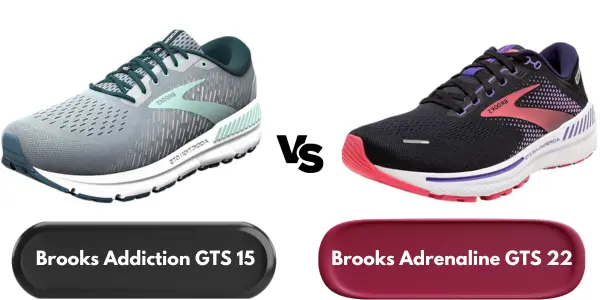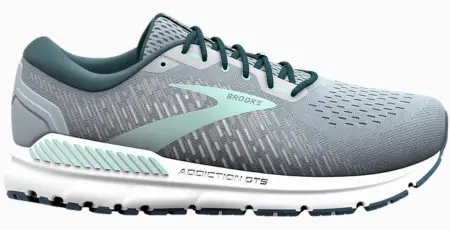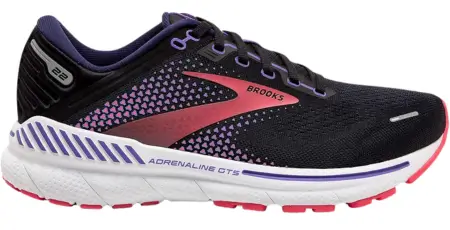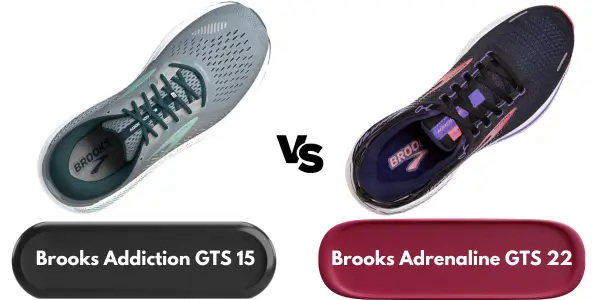Brooks Addiction GTS 15 vs Brooks Adrenaline GTS 22
Last Updated: January 01, 2025 | Author: Jake Thompson
As the saying goes, 'different strokes for different folks,' and this certainly rings true when comparing the Brooks Addiction GTS 15 and the Adrenaline GTS 22 running shoes. These are carefully chosen from the diverse range of shoes Brooks offers with its popularity on the rise than ever before. I've experienced firsthand that what works for one runner may not suit another.
The Addiction 15, with its focus on motion control, caters to runners who need extra help with overpronation, offering a level of stability that's hard to match.

On the other hand, the Adrenaline GTS 22, with its innovative GuideRails support system, provides a balanced blend of cushioning and support that adapts to a runner's unique stride.
In my professional opinion, the choice between these two isn't black and white; it hinges on a nuanced understanding of one's running mechanics and preferences.
So, let's lace up, and I'll guide you through the subtle yet significant differences between these two popular Brooks models, helping you to pinpoint which pair might elevate your running experience to new heights.
To see how other models in the Brooks range compare, take a look at our detailed review of Brooks Levitate vs. Adrenaline, which offers insights into these popular running shoes.
Table of Content:
- Key Takeaways
- Table: Brooks Addiction GTS 15 vs Brooks Adrenaline GTS 22
- Performance Comparison
- Responsiveness
- Stability
- Grip
- Comfort
- Cushioning
- Flexibility and Weight
- Lightness
- Midsole Technologies
- Target Audience and Usage
- Additional Features
- Frequently Asked Questions
Key Takeaways
- - The Adrenaline GTS 22 is rated higher overall and is suitable for severe pronation, while the Addiction GTS 15 is rated lower and offers motion control for severe pronation.
- - The Adrenaline GTS 22 has balanced cushioning, while the Addiction GTS 15 has plush cushioning.
- - The Adrenaline GTS 22 is moderately flexible and lighter in weight, while the Addiction GTS 15 is more flexible and slightly heavier.
- - The Addiction GTS 15 is designed for severe pronation and motion control, suitable for heavy body weights, and has additional features like GuideRails Technology and synthetic overlays.
- -The Adrenaline GTS 22 is ideal for road running, cross-training, and daily training, provides support for hips, knees, and joints, and has features like a 3D Fit Print upper and heel counter.
Table: Brooks Addiction GTS 15 vs Brooks Adrenaline GTS 22
 |
 |
|
|---|---|---|
| Aspect | Brooks Addiction GTS 15 | Brooks Adrenaline GTS 22 |
| Support | Severe Pronation Control | Stability and Support |
| Feel | Plush Cushioning | Balanced Cushioning |
| Flexibility | Flexible | Moderate |
| Drop-mm (M/W) | 12 | 12 |
| Weight-gr (M/W) | 345 / 315 | 289 / 300 |
| Width Options | Narrow / Normal / Wide / XWide | Narrow / Normal / Wide / XWide |
| Cushion | Soft and protective to cushion your every step | Soft and responsive cushioning with a smooth heel-to-toe transition |
| Outsole | HPR Plus rubber for durable traction | HPR Plus rubber for durable traction |
| Midsole | BioMoGo DNA cushioning adapts to your stride, weight, and speed for a customized feel | BioMoGo DNA and DNA LOFT cushioning for a soft and responsive ride |
| Price |
Performance Comparison
When comparing the performance of Brooks Addiction GTS 15 and Adrenaline GTS 22, it's crucial to examine their responsiveness, stability, and grip.
I'll consider how the cushioning technologies and design structures of both models contribute to the overall running experience.
It's important to assess how these factors play into the efficiency and safety of the runner, particularly on different terrains and during various running dynamics.
Related: Brooks Beast vs Addiction
Responsiveness
While comparing the responsiveness of the Brooks Addiction GTS 15 and the Adrenaline GTS 22, one must consider the distinct midsole technologies and their impact on a runner's performance. The Addiction 15 utilizes BioMoGo DNA to achieve a balance of softness and responsiveness. However, the Adrenaline GTS 22 steps up the game with a dual foam system, combining BioMoGo DNA with DNA Loft, which includes EVA for a plush yet responsive ride.
- - BioMoGo DNA: Both running shoes incorporate this for adaptive cushioning.
- - DNA Loft: Exclusive to Adrenaline GTS 22, it enhances responsiveness using a blend of EVA, air, and rubber.
- - Cushion Level: The Addiction 15 offers a plush cushion, whereas the Adrenaline GTS 22 provides balanced cushioning.
- - Support Features: Adrenaline GTS 22 includes an additional structure for responsive support, particularly beneficial during longer runs.
Stability
Building on the discussion of cushioning and responsiveness, it's essential to analyze how the Brooks Addiction GTS 15 and Adrenaline GTS 22 perform in terms of stability, a critical factor for runners with severe pronation.
In comparison, both shoes are designed to address overpronation, but they do so through different approaches.
For a deeper understanding of how Brooks designs cater to different running needs, check out our comparison of Brooks Adrenaline vs Glycerin.
The Addiction 15, with its motion control design, offers a straighter last and higher stack height, providing a secure and supportive ride, particularly for heavier runners.
On the other hand, the Adrenaline GTS 22 features the GuideRails Technology, which works to align the hips, knees, and joints, thus offering stability without over-correcting one's stride.
Both shoes are competent in their stability, but the choice may hinge on the runner's preference for cushioning level and the specific type of support they require for their running gait.
Grip
Considering the critical importance of traction, especially for runners tackling diverse terrains, the Brooks Addiction GTS 15 and Adrenaline GTS 22 differ notably in their outsole design and grip performance.
The Brooks Addiction is known for its substantial outsole, which provides a reliable grip and is an excellent option for those who require a shoe that can handle various surfaces.
On the other hand, the Brooks Adrenaline is designed with a more versatile outsole that offers a balance between grip and flexibility, making it suitable for both road running and light trail use.
- - Brooks Addiction GTS 15: Durable outsole with substantial tread for various terrains.
- - Brooks Adrenaline GTS 22: Balanced outsole for multi-surface grip.
- - Traction Comparison: Addiction 15 favors stability, Adrenaline 22 versatility.
Both provide reliable grip, but with different performance focuses.
Comfort
When comparing the comfort of Brooks Addiction GTS 15 and Adrenaline GTS 22, cushioning is a crucial factor to consider.
The Addiction 15 features plush cushioning, rated 3/3, providing a softer underfoot experience, which may be preferred by runners seeking maximum comfort.
In contrast, the Adrenaline GTS 22 offers balanced cushioning with a combination of BioMoGo DNA and DNA Loft, potentially appealing to those who prioritize a blend of softness and responsiveness.
Cushioning

Regarding cushioning—a critical aspect for comfort in running shoes—the Brooks Addiction GTS 15 offers a plush experience, ranking highest with a 3/3 score, while the Adrenaline GTS 22 delivers balanced cushioning with a 2/3 score.
When it comes to training for a marathon or any long-distance running, the right blend of cushioning can make a significant difference. Here's an analytical breakdown:
- - The Addiction GTS 15's cushioning is designed to provide maximum comfort, which is vital for extended periods of wear.
- - Adrenaline GTS 22's cushioning offers a combination that balances comfort with responsiveness, suitable for varied training regimens.
- - Both shoes use BioMoGo DNA technology, but the Addiction includes a higher stack height for a softer feel.
- - The Adrenaline GTS 22 integrates DNA Loft, Brooks' softest cushioning, to ensure a smooth ride.
Flexibility and Weight
Turning to flexibility and weight, I notice that the Adrenaline GTS 22 offers moderate flexibility and is lighter compared to the Addiction 15, which is important for runners who prioritize agility and a less cumbersome feel.
However, the Addiction 15's greater flexibility might appeal to those seeking a shoe allowing more natural foot movement. Both aspects are crucial in determining the overall performance and suitability of the shoe for different runners, with the weight being a key factor in comfort during long runs.
Lightness
In comparing the Brooks Addiction GTS 15 and Adrenaline GTS 22, it's notable that while both provide substantial support for severe pronation, they differ markedly in their approach to flexibility and weight, factors that are crucial for runners prioritizing lightness in their footwear.
The Addiction 15 is designed with a focus on motion control, which, though beneficial for flat-footed runners, results in a shoe that's notably heavier than the Adrenaline GTS 22. The Addiction 15 offers a rigid structure aimed at stability, trading off some lightness.
On the other hand, the Adrenaline GTS 22 balances support with a lighter frame, enhancing agility. Flexibility in the Adrenaline GTS 22 may appeal to those who prefer a more natural foot movement.
Weight considerations are pivotal when I recommend shoes to distance runners. Both shoes have their place, but for runners seeking a lighter shoe, the Adrenaline GTS 22 might be the more suitable option.
Midsole Technologies
Examining the midsole technologies of the Brooks Addiction GTS 15 and the Adrenaline GTS 22 reveals a significant difference in their approach to providing support and cushioning for runners with severe pronation.
The Addiction 15 uses BioMoGo DNA for its midsole, which offers plush cushioning and responsiveness, tailored to those who need more motion control due to their gait. Its straighter last adds support for a stabilizing effect.
In contrast, the Adrenaline GTS 22 combines BioMoGo DNA with DNA Loft, Brooks' softest foam, to create a dual-foam midsole that balances softness with durability. This midsole is best for runners who like a blend of cushioning and support.
When you choose between these shoes, it's essential to consider these midsole technologies for your specific needs.
Related: Brooks Ghost vs Adrenaline
Target Audience and Usage
Understanding the unique midsole technologies in the Brooks Addiction GTS 15 and Adrenaline GTS 22 leads naturally to exploring who'll benefit most from these features in their daily running or training routines.
The Brooks Adrenaline GTS shines for both men and women who seek a blend of support and cushioning, tailored for moderate to severe pronation during road running or cross-training. Men and women with pronation issues will find the Brooks Adrenaline GTS line offers the necessary stability.
Those looking to buy a shoe for everyday training can consider the versatile usage of the Adrenaline GTS 22. The Addiction 15 caters to runners needing maximum motion control. Both shoes serve as solid choices for individuals prioritizing foot support and comfort in their athletic footwear.
Additional Features
While both the Brooks Addiction GTS 15 and Adrenaline GTS 22 offer core functionalities for severe pronators, their additional features cater to different runners' needs and preferences with precision. For instance, the Adrenaline GTS 22 integrates a 3D Fit Print upper that not only supports the foot but also enhances the fit. This is a reason why runners might choose it first. On the other hand, the Addiction 15 has a straighter last which is another way to ensure added support for those with severe overpronation.
| Feature | Addiction 15 | Adrenaline GTS 22 |
|---|---|---|
| Upper Construction | Synthetic Overlays | 3D Fit Print Upper |
| Support Type | Straighter Last | GuideRails Technology |
| Cushioning Material | BioMoGo DNA | DNA Loft + BioMoGo DNA |
For a broader perspective on running shoe options, our review of Brooks Ghost vs. Revel provides a comprehensive comparison.
Frequently Asked Questions
1. How Do the Brooks Addiction GTS 15 and Adrenaline GTS 22 Compare in Terms of Their Environmental Impact and Sustainability Efforts?
I'm not currently informed on the specific environmental impacts or sustainability efforts of these shoes. Typically, such information would be provided by the manufacturer's sustainability reports or product materials.
2. What Specific Design Elements Have Been Incorporated in the Brooks Addiction GTS 15 and Adrenaline GTS 22 to Cater to Runners With Different Biomechanical Needs?
I've noticed that the Addiction 15 features motion control and plush cushioning, while the Adrenaline GTS 22 offers balanced cushioning with a dual foam midsole, catering to different stability and support needs.
3. Can the Brooks Addiction GTS 15 and Adrenaline GTS 22 Be Used Effectively for Activities Other Than Running, Such as Walking or Gym Workouts?
Any supportive shoe can cross over to walking or gym workouts, but it's crucial to ensure they provide the right balance of comfort and stability for those specific activities.
To find the best shoes for walking, check out our top picks.
4. How Do the Wear and Tear Resistance of the Outsole Materials in the Brooks Addiction GTS 15 and Adrenaline GTS 22 Compare?
I've found that outsole durability largely depends on the materials and tread design. Generally, high-abrasion rubber offers better wear resistance, and a denser tread pattern can enhance the outsole's longevity.
5. Are There Any Unique Maintenance or Care Instructions for the Brooks Addiction GTS 15 and Adrenaline GTS 22 to Ensure They Maintain Their Performance Over Time?
When maintaining running shoes, I always follow the manufacturer's care instructions to preserve their performance, such as cleaning them properly, avoiding harsh conditions, and storing them in a cool, dry place.
Share this:







